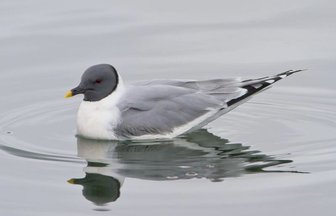Sabine's gull
This species is easy to identify through its striking wing pattern. The adult had a pale grey back and wing coverts, black primary flight feathers and white secondaries. The white tail is forked. The male's hood darkens during breeding season. Their bills are black with a yellow tip. Young birds have a similar tricoloured wing pattern, but the grey is replaced by brown, and the tail has a black terminal band. The juveniles take two years to attain full adult plumage. They have a very high-pitched and squeaking call.

Original source: Sabine´s Gull - Larus sabini - ÞernumáfurUploaded by Snowmanradio
Author: Ómar RunólfssonOther versions
The Sabine's gull is classified as Least Concern. Does not qualify for a more at risk category. Widespread and abundant taxa are included in this category.
Sabine's Gull (Xema sabini), The Birds of North America Online (A. Poole, Ed.). Ithaca: Cornell Lab of Ornithology; Retrieved from the Birds of North America Online: http://bna.birds.cornell.edu/bna/species/593 doi:10.2173/bna. More
The Sabine's Gull is a small gull. Its generic placement is disputed; some authors treat it as the sole species in the genus Xema as Xema sabini, while others retain it in the genus Larus as Larus sabini. It breeds in the arctic and has a circumpolar distribution through northernmost North America and Eurasia. More
Sabine's Gull: Breeds on coastal wet tundra in the arctic, including northern and western Alaska, arctic Canada, northern Greenland, Spitzbergen, and across northern Siberia. Outside breeding season, it is essentially pelagic, found in the eastern Pacific between southern Baja California and central Chile; concentrates in the tropics in the Atlantic. More
* Although most Sabine's Gulls migrate along the coasts or at sea, some migrate directly north-south, directly across North America. * The only member of its genus, the Sabine's Gull is like no other gull. Many of its behaviors resemble those of terns more than gulls. Habitat - Ocean * Nests on moist tundra ground, usually near fresh water. More
The Sabine's Gull breeds in colonies on coasts and tundra, laying two or three spotted olive-brown eggs in a ground nest lined with grass. It is very pelagic outside the breeding season. It takes a wide variety of mainly animal food, and will eat any suitable small prey. It also steals eggs from nesting colonies of Arctic Terns. This bird was named after the Irish scientist Sir Edward Sabine by his brother Joseph Sabine. More
North American RangeThe Sabine's Gull is a small gull with a graceful, tern-like flight. This gull has a slate-gray back, a white belly and tail, and black wingtips. The adult has a black bill with a yellow tip. The middle of the wings is white, giving the bird a distinctive 'M' pattern across its wings in flight. In breeding season, the adult has a dark gray hood, edged in black. The adult in non-breeding plumage has a partially gray and white head. More
* Sabine's Gulls occur in small numbers or are found only in localized sites within the Great Plains. More
Unlike most gulls which are coastal, Sabine's Gull is truly pelagic when not breeding. It is highly migratory (breeds in the arctic, vacations below the equator) unlike most other gulls which disperse only within the region. In both of these characteristics it is more like a tern. Most gulls have a complete molt in the fall and a partial molt in the spring. More
Sabine's Gull is unique amongst gulls in having a complete pre-breeding molt in the winter quarters followed by a partial post-breeding molt in the late summer. Immatures retain juvenile plumage during the first autumn on the wintering grounds. First-winter birds undergo a full molt in late winter/early spring and normally remain on the wintering grounds while adults travel north. More
Sabine's gull at the Logan Polishing Ponds (part of the Logan wastewater treatment complex). The bird was at the northeast corner of the northeast pond, amidst a flock of Franklin's gulls. The Sabine's gull is an unusual and distinctive Arctic gull usually found in far northern latitudes during breeding season. They winter near the tropics. Perhaps it is a sign of warmer times for Utah this winter, if the bird decides to stay here. More
Pierre Deviche found an adult Sabine's Gull at the ponds on 9/11, and I was looking hard. The first one I saw was a juvenile swimming on Pond #3; before long it flew off to the west. When I reached the final pond (#10), I was happy to find not just the juvenile, but the adult Sabine's Gull there as well! They were bobbing their heads in the water and swimming about. Soon the youngster took off. More
Sabine's Gulls are rare but yearly in The Netherlands. They usually turn up during or shortly after NW-storms. A seawatch during such a spell in October often produces one or more Sabine's Gulls. But they are (nearly) always juvenile birds. September or even late August proves to give a relatively higher chance of seeing adult birds. This is what happened after a number of days with strong NW-winds in early September 2001. More


